People who grow up in low-income households face significant hardships compared to those who do not: they are less likely to succeed in school, less likely to obtain high educational degrees, more likely to have low incomes, and even more likely to be incarcerated. People from minority backgrounds (a characteristic that largely overlaps with low socioeconomic status) show underperformance on these measures as well. We use the term "achievement gap" as a general reference to these sorts of disparities, which reflect the idea that some people in our society are apparently less likely to succeed - by both academic and career-related measures - from the day they enter school.
The aim of this page is not to give a thorough analysis of any particular achievement gap, nor to address theories about the cause(s) of these gaps, but rather to provide a basic illustration of:
- The differences in academic performance and later life outcomes between people from high- and low-socioeconomic-status households.
- The differences between African-Americans and whites on the same measures. (The "achievement gap" between African-Americans and whites overlaps largely with the one between those from high- and low-socioeconomic-status households, but is more frequently discussed in research, likely because more data is available on it).
- The fact that the achievement gap - by either of the above two definitions - is present very early in life, and therefore is unlikely to be fully explained by a gap in quality of education (although this gap does appear to exist).
Table of Contents
The charts below illustrate that people from lower-income families have lower high-school graduation rates, lower incomes, and higher likelihood of being arrested and incarcerated. (Information on the data follows.)
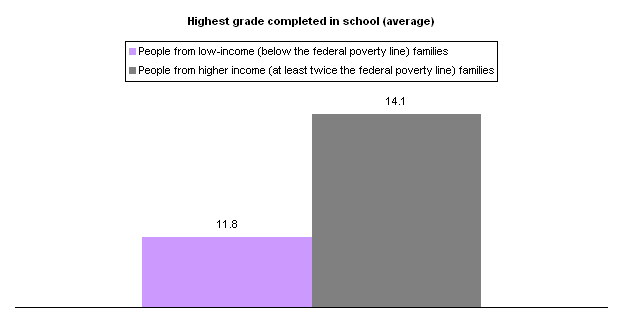
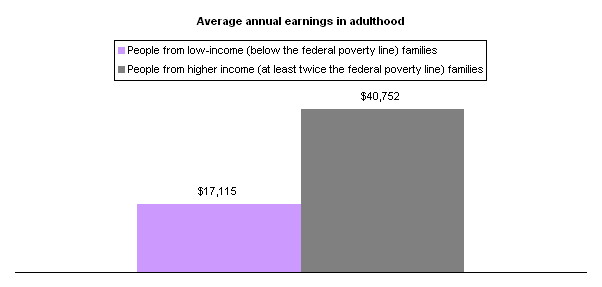

More information on the poverty line is available here.
Notes on the data used above
Collecting data on the "socioeconomic status achievement gap" is relatively challenging, since it requires following a single set of people from childhood through adulthood. (The aim is to examine life outcomes by the socioeconomic status of the family they grew up in). One relevant data source is the Panel Study on Income Dynamics (PSID), a nationally representative longitudinal study that has been collecting data on U.S. families since 1968.
The following charts are taken from data provided in Duncan 2008 (full citation below), a paper that examines all individuals in the PSID sample who were born between 1968 and 1975 and whose families responded consistently between birth and age 15 (Pg 11).
Gaps in life outcomes, by ethnicity
The paper cited above, Duncan 2008 (full citation (below), shows that African-Americans and other minorities are more likely to have low socioeconomic status than whites.
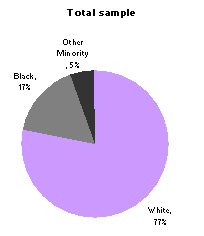
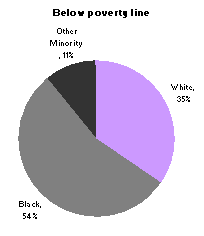
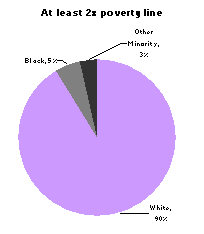
The achievement gap between different ethnicities looks broadly similar to the achievement gap between people of different socioeconomic status, but there is frequently more and better data available on it (likely because it is easier to record a subject's ethnicity than to record their childhood socioeconomic status). Discussions in academic research frequently focus on the achievement gap between African-Americans and whites.
The following charts illustrate the achievement gap between African-Americans and whites; though this data (details below the charts) is not strictly comparable to the above-cited data on the socioeconomic achievement gap, it also implies a substantial gap in life outcomes.


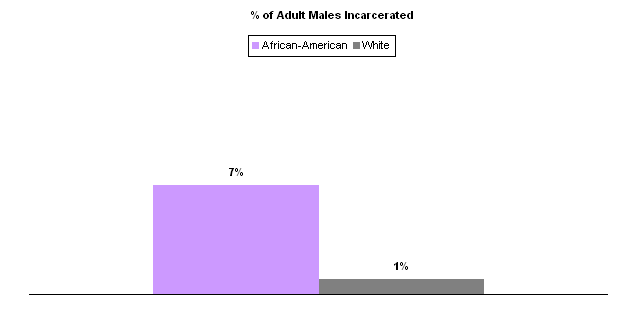
Educational attainment data in the charts above comes from U.S. Census Current Population Survey for 2006 (available here). Earnings data comes from the U.S. Census Current Population Survey for 2007 (available here). Prison statistics come from The Pew Center for the State's report “One in 100: behind bars in America in 2008” (available here).
Academic gaps at early ages
The achievement gaps discussed above are sometimes attributed to the public school system, and there is some evidence of a "school quality" gap mirroring the achievement gap (for example, see "Parsing the Achievement Gap" Pg 7). However, while it is possible that improved schooling would lead to improved later-life outcomes, we find it very important to note that strong signs of the achievement gap are present before the age of five.
The following charts illustrate that low-socioeconomic-status children underperform higher-socioeconomic-status children in kindergarten, and the gap widens only slightly afterward. A similar picture holds for African-American children vs. white children.
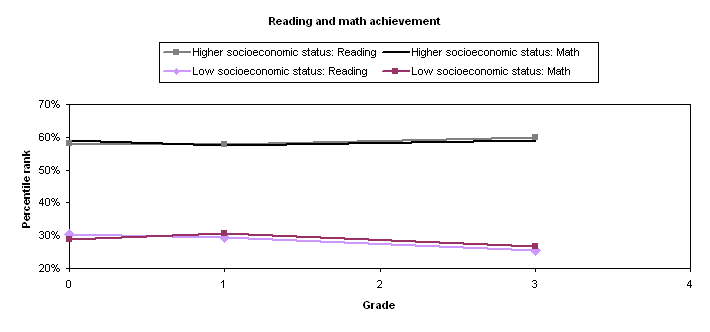
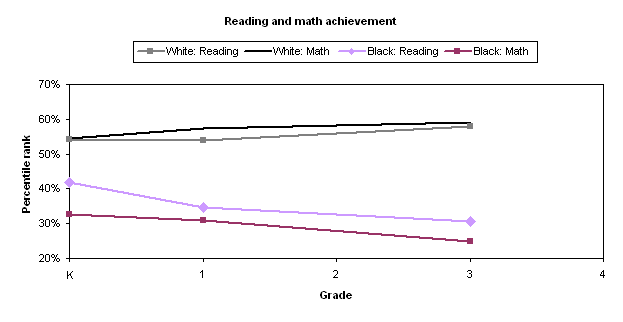
Data is taken from Rathbun 2004 (full citation below). Note that this source provides mean scale scores, not percentile ranks; we converted the scores to percentile ranks by assuming a normal distribution and using the data on standard deviations found in Murnane 2006 (the paper is not available online, but we provide the data and calculations in question here (XLS format)).
Interpretation
There are widespread differences of opinion on the root causes behind the achievement gap. For our purposes, we find it unnecessary to take a position on what factor, or combination of factors, plays the largest part in the disparities discussed above; but we believe it is important to emphasize the largely undisputed point that the achievement gap cannot be entirely attributed to differences in people's environment and resources after the age of five; important differences in academic achievement are already present by the time people enter kindergarten.
This does not mean that post-kindergarten interventions are necessarily ineffective; but we believe it does justify approaching such interventions with skepticism, i.e., not assuming that a given education program improves a child's performance unless there is a strong empirical case that it can do so.
References
- Duncan, G. J., Kalil, A. & Ziol-Guest, K. 2008. "The economic costs of early childhood poverty," Partnership for America's Economic Success, Issue Paper #. Available online.
- Murnane, R.J., Willett, J.B., Bub, K.L. & McCartney, K. 2006. "Understanding trends in the black-white achievement gaps during the first years of school," Brookings-Wharton Papers on Urban Affairs.
- Rathbun, A., West, J. & Hausken, E. G. 2004. "From Kindergarten through the third grade: children's beginning school experiences," National Center for Educational Statistics. Available online.
- Barton, Paul E. 2003. "Parsing the achievement gap: baselines for tracking progress," Educational Testing Service. Available online.
